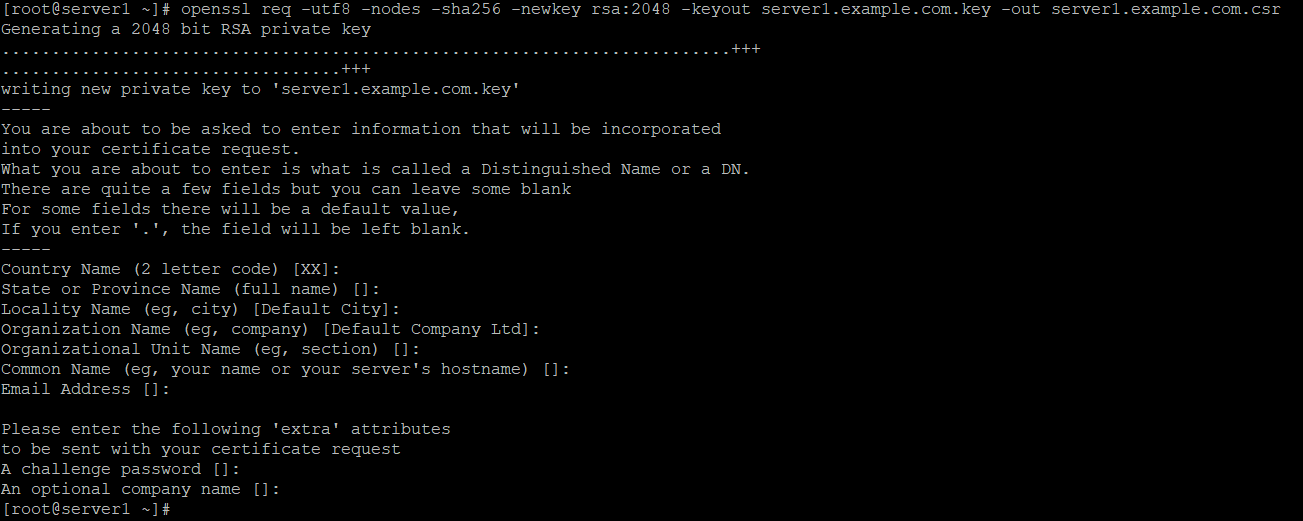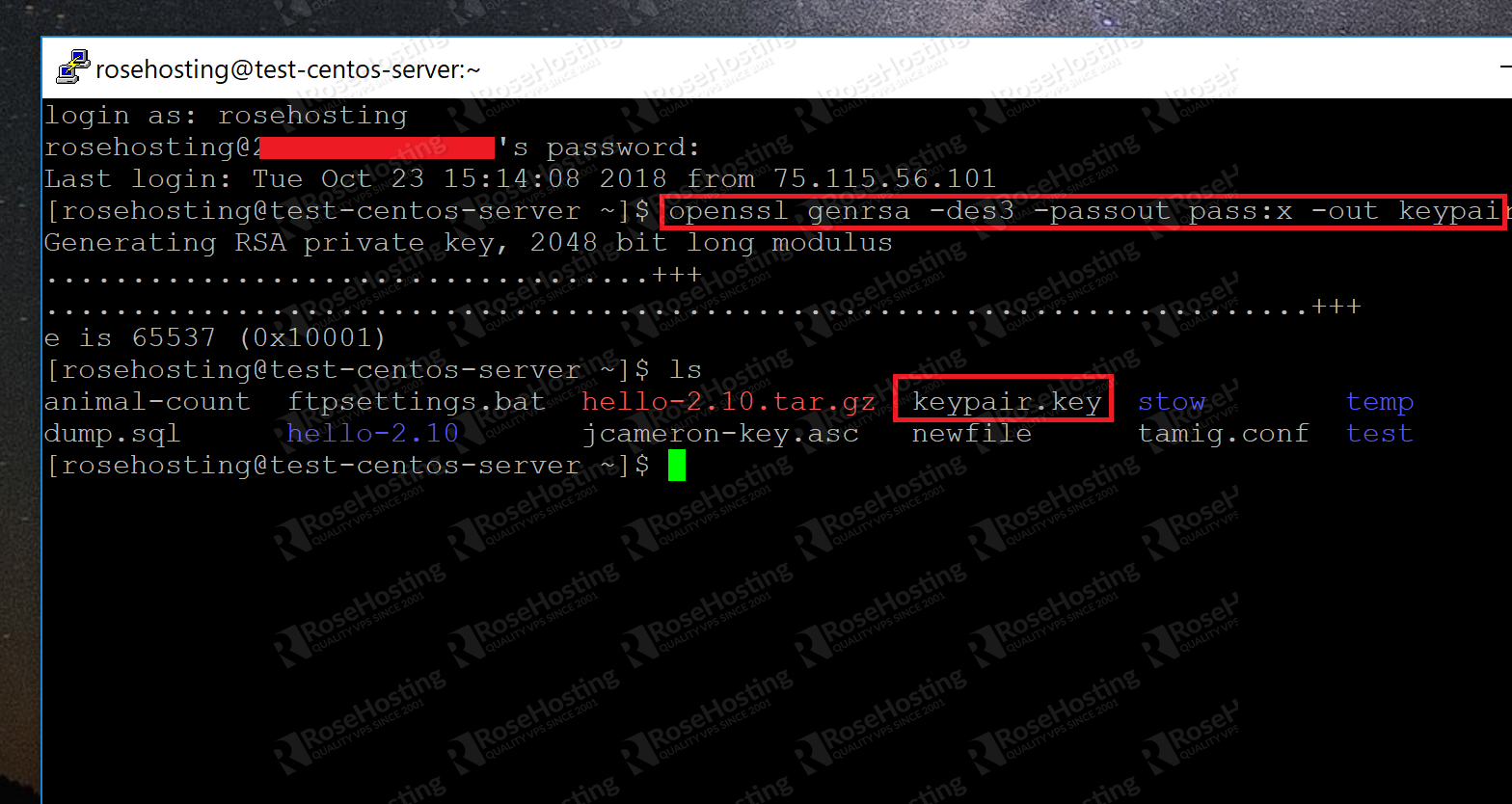Openssl Generate Rsa Key And Certificate
Posted By admin On 16.04.20- Openssl Generate Rsa Key And Certificate Download
- Openssl Generate Rsa Key And Certificate Online
- Openssl Generate Rsa Key And Certificate Registration
- Openssl Generate Rsa Key And Certificate Download
While Encrypting a File with a Password from the Command Line using OpenSSLis very useful in its own right, the real power of the OpenSSL library is itsability to support the use of public key cryptograph for encrypting orvalidating data in an unattended manner (where the password is not required toencrypt) is done with public keys.
Mar 03, 2020 Generating an RSA key with a self-signed X.509 certificate. If you're validating keys against registry-level certificates, the certificate must meet certain requirements. One of these requirements is that the certificate use the X.509 standard. To generate a 2048-bit RSA private key and a self-signed X.509 certificate with a SHA-256 signature. Reasons for importing keys include wanting to make a backup of a private key (generated keys are non-exportable, for security reasons), or if the private key is provided by an external source. This document will guide you through using the OpenSSL command line tool to generate a key pair which you can then import into a YubiKey. Jul 22, 2017 Create a new 4096bit RSA key and save it to serverkey.pem, without DES encryption (-newkey, -keyout and -nodes) Create a Certificate Signing Request for a given subject, valid for 365 days. As before, you can encrypt the private key by removing the -nodes flag from the command and/or add -nocerts or -nokeys to output only the private key or certificates. So, to generate a private key file, we can use this command: openssl pkcs12 -in INFILE.p12 -out OUTFILE.key -nodes -nocerts. And to create a file including only the certificates.
Reasons for importing keys include wanting to make a backup of a private key (generated keys are non-exportable, for security reasons), or if the private key is provided by an external source. This document will guide you through using the OpenSSL command line tool to generate a key pair which you can then import into a YubiKey. The G Suite Single Sign-On service accepts public keys and certificates generated with either the RSA or DSA algorithm. To use the service, you need to generate the set of public and private keys and an X.509 certificate that contains the public key. Once you have a public key or certificate, you would then need to register it with Google.
The Commands to Run
Generate a 2048 bit RSA Key
You can generate a public and private RSA key pair like this:
openssl genrsa -des3 -out private.pem 2048
That generates a 2048-bit RSA key pair, encrypts them with a password you provideand writes them to a file. You need to next extract the public key file. You willuse this, for instance, on your web server to encrypt content so that it canonly be read with the private key.
Export the RSA Public Key to a File
This is a command that is
openssl rsa -in private.pem -outform PEM -pubout -out public.pem
The -pubout flag is really important. Be sure to include it.
Next open the public.pem and ensure that it starts with-----BEGIN PUBLIC KEY-----. This is how you know that this file is thepublic key of the pair and not a private key.
To check the file from the command line you can use the less command, like this:
less public.pem
Do Not Run This, it Exports the Private Key
A previous version of the post gave this example in error.
openssl rsa -in private.pem -out private_unencrypted.pem -outform PEM
Windows 7 ultimate upgrade key generator. How to Upgrade to Windows 7 Ultimate for Free. Windows 7 Home Premium Key. Windows 7 Professional Key. Windows 7 Ultimate Key. Soon, I’ll post details about upgrading to Windows 8.1 and Windows 10 for Free as well. Join the Conversation. Tera Baap says: Windows 8 or 8.1 ki working keys post kar. Ab sab 8 or 8.1 hi post kar rahe hai.

The error is that the -pubout was dropped from the end of the command.That changes the meaning of the command from that of exporting the public keyto exporting the private key outside of its encrypted wrapper. Inspecting theoutput file, in this case private_unencrypted.pem clearly shows that the keyis a RSA private key as it starts with -----BEGIN RSA PRIVATE KEY-----.
Visually Inspect Your Key Files
It is important to visually inspect you private and public key files to makesure that they are what you expect. OpenSSL will clearly explain the nature ofthe key block with a -----BEGIN RSA PRIVATE KEY----- or -----BEGIN PUBLIC KEY-----.
You can use less to inspect each of your two files in turn:
less private.pemto verify that it starts with a-----BEGIN RSA PRIVATE KEY-----less public.pemto verify that it starts with a-----BEGIN PUBLIC KEY-----
The next section shows a full example of what each key file should look like.
The Generated Key Files
The generated files are base64-encoded encryption keys in plain text format.If you select a password for your private key, its file will be encrypted withyour password. Be sure to remember this password or the key pair becomes useless.
The private.pem file looks something like this:
The public key, public.pem, file looks like:
Protecting Your Keys
Depending on the nature of the information you will protect, it’s important tokeep the private key backed up and secret. The public key can be distributedanywhere or embedded in your web application scripts, such as in your PHP,Ruby, or other scripts. Again, backup your keys!
Remember, if the key goes away the data encrypted to it is gone. Keeping aprinted copy of the key material in a sealed envelope in a bank safety depositbox is a good way to protect important keys against loss due to fire or harddrive failure.
Oh, and one last thing.
If you, dear reader, were planning any funny business with the private key that I have just published here. Know that they were made especially for this series of blog posts. I do not use them for anything else.
Found an issue?
Openssl Generate Rsa Key And Certificate Download
Rietta plans, develops, and maintains applications.
Learn more about our services or drop us your email and we'll e-mail you back.
Other Blog Articles Published by Rietta.com
Generate CSR - OpenSSL
Introduction

This article provides step-by-step instructions for generating a Certificate Signing Request (CSR) in OpenSSL. This is most commonly required for web servers such as Apache HTTP Server and NGINX. If this is not the solution you are looking for, please search for your solution in the search bar above.
Switch to a working directory
GNU/Linux & Mac OS X users:
Open a terminal and browse to a folder where you would like to generate your keypair
Windows Users:
Navigate to your OpenSSL 'bin' directory and open a command prompt in the same location.
Generate a CSR & Private Key:
openssl req -out CSR.csr -new -newkey rsa:2048 -keyout privatekey.key
To generate a 4096-bit CSR you can replace the rsa:2048 syntax with rsa:4096 as shown below.
openssl req -out CSR.csr -new -newkey rsa:4096 -keyout privatekey.key
Openssl Generate Rsa Key And Certificate Online
Note: You will be prompted to enter a password in order to proceed. Keep this password as you will need it to use the Certificate.
Openssl Generate Rsa Key And Certificate Registration
Fill out the following fields as prompted:
Note: The following characters can not be accepted: < > ~ ! @ # $ % ^ * / ( ) ?.,&
| Field | Example |
|---|---|
| Country Name | US (2 Letter Code) |
| State or Province | New Hampshire (Full State Name) |
| Locality | Portsmouth (Full City name) |
| Organization | GMO GlobalSign Inc (Entity's Legal Name) |
| Organizational Unit | Support (Optional, e.g. a department) |
| Common Name | www.globalsign.com (Domain or Entity name) |
Openssl Generate Rsa Key And Certificate Download
You should now have a Private Key (privatekey.key) which should stay on your computer, and a Certificate Signing Request (CSR.csr), which can be submitted to GlobalSign to sign your public key. Each of these files can be viewed in a plain text editor such as Notepad, TextEdit, Vi, Nano, and Notepad++.